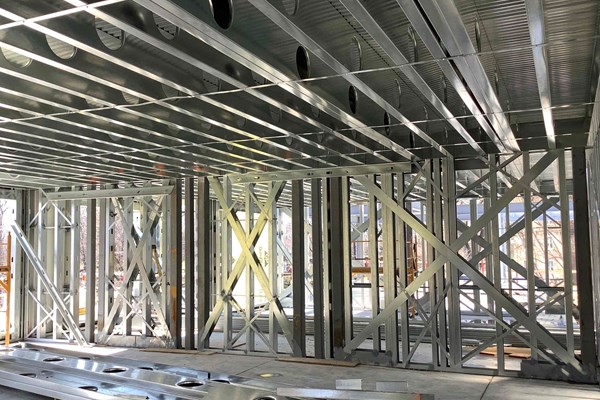
2020 proved to be an extremely volatile year for the construction industry. As the pandemic settled in across the country, few firms remained unscathed from its effects. Many projects were delayed or canceled, resulting in companies laying off or furloughing office personnel and craftspeople.
Still, the construction industry demonstrated resilience. Companies quickly adjusted to the new protocols around personal protective equipment, daily health screenings and adopted physical distancing guidelines on the job site to protect workers and the public. As new projects began to move forward, contractors began hiring back furloughed workers and recruiting new skilled workers.
Resiliency notwithstanding, one consequence of the pandemic that continues to challenge contractors is the rise in material prices. The cost of most materials has skyrocketed in the last year, the result of a worldwide supply chain still crippled by the virus.
While aggressive bidding for fewer projects served to keep total construction costs relatively flat in 2020, the continuing price increases in materials are causing sleepless nights among developers and contractors, wrestling to secure financing and complete projects within budget.
The Reason Behind the Skyrocketing Material Costs
It’s easy to understand why material costs are rising rapidly. The pandemic shut down factories across the globe as employees were either quarantined or furloughed. Likewise, some seaports had to temporarily shut down, causing a bottleneck of cargo ships waiting to unload. When you consider that China, the first country to experience the coronavirus outbreak, is the source of an estimated 30% of our building materials. it is easy to understand why the supply chain became crimped so quickly, strangling the delivery of materials to construction sites and leading to surging prices.
Material Prices Are Expected to Continue Rising in 2021
According to CPE (Commercial Property Executive), material costs are expected to rise between 4 to 6 percent in 2021. The resultant spike in prices will be across the board. This year, we are expected to experience an all-category monthly increase for the first time since July 2018.
Numbers provided by the Bureau of Labor Statistics show that, from December 2019 through December 2020, copper and brass prices increased 20 percent, with a 4 percent increase in the price of gypsum (drywall). Meanwhile, driven mainly by increased energy costs, concrete products increased 2.4 percent.
The real eye-popping number has to be the 36.1 percent increase in the price of lumber and plywood!
Strong residential demand fueled the rise in lumber pricing. Production problems with lumber mills in Canada and increased demand from all those temporary COViD-19 protection barriers built around the country helped deplete inventories. Exacerbating the cost was a 20% tariff on Canadian lumber imposed in 2017. While that tariff was lowered to 9% in 2020, lumber prices remain extremely volatile.
It makes one wonder...”Will metal studs eventually become cheaper than lumber studs?”
Are Metal Studs the Right Solution to Rising Lumber Prices?
Opinions vary on the advantages of using metal studs in place of wood as a value-engineering solution to the rising cost of lumber. Indeed, no one expected lumber prices - or on steel for that matter - to climb as high as they already have.
While lumber and steel are both primary building materials, switching from a combination of wood and metal framing to all-metal simply to avoid high lumber costs would be a mistake. True, some partisans will tout the benefits of one combination over another, as discussed in our pre-pandemic blog titled "Wood Versus Steel Framing: Is the Cost Savings Worth It?"
However, it is important to note that steel prices are up also. “Pricing and lead times for metal framing have increased for many metal framing products in the first half of 2021,” stated Chuck Haba of Telling Industries, a manufacturer of premium metal framing.
Haba noted that the US domestic steel market took capacity offline in 2020 due to COVID-related shutdowns in the automotive and appliance industries. This was at a time when consumer demand for these products was increasing. Similar lockdowns worldwide affected global supply chains. Then too, labor outages resulted when factories had to quarantine infected employees. “The combination of US Steel Market challenges plus the Worldwide Supply Chain shortages plus the Rolling Labor Outages has caused higher prices and longer lead times,” said Haba.
Contractors Are Finding Ways to Cope with the Price Increases
Contractors are adopting new ways to operate efficiently and reduce waste to combat rising material costs. These include increased use of prefabrication and lean construction techniques and increased reliance on BIM and other field software technology. Contractors are also value-engineering different materials on existing projects to keep those projects on track, such as substituting OSB for plywood. Agreements are covering significant price increases, called force majeure clauses, are increasingly being written into contracts with developers to protect contractors from taking a bath on uncontrollable material cost surges.
In summary, most experts expect market economics of supply and demand to eventually eliminate supply shortages, resulting in prices leveling off and even dropping in 2022. The higher steel prices have created a more lucrative supply incentive for producers to turn their furnaces back on. Daniel Pomfrett, V.P. of Cumming, a cost consulting firm to the construction industry, is projecting steel prices to begin decreasing again and be near pre-pandemic levels by the end of 2021, even as demand increases.
It is logical to expect the same market forces to play out on lumber prices. Once supply and demand equalize, residential building slows, and the lumber supply chain catches up, prices should stabilize, and perhaps contractors will once again sleep soundly.